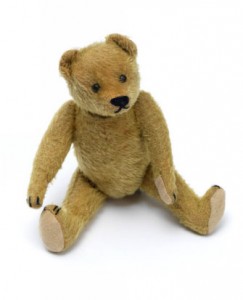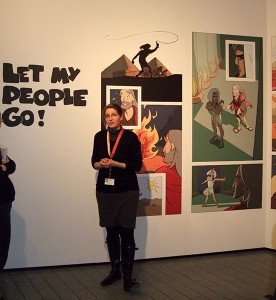
Teddy bear that belonged to Ilse Jacobson (1920-2007), textile, straw, glass, ca. 1920 to 1930, in our online collection
56,250. This is the number that comes up when I search our collection’s database for its complete holdings. 56,250 data sets describing, for the most part, individual objects, and occasionally entire mixed lots. You can now see 6,300 of these objects online. Releasing this information to the public provokes mixed feelings on the part of museum staff: we have a lot to say about many of these objects. Many of them don’t speak for themselves. You can’t tell, for instance, that this teddy bear belonged to a child emigrating from Germany. The meaning of many documents and photographs lies likewise to a large extent in their biographical or political history. They require sufficient detail and well-chosen catchwords to help visitors find other objects related to the same topic.
With this project, we have to proceed pragmatically. 15-30 minutes of working time per object is a lot if you have to inventory a mixed lot with 250 units. We verify everything, including things that occur to us as we’re working. We are aware that there’s more to write about – and there would be more to correct, – if we had the time for more thorough research. Yet we can only make forays into the library or even into the archive for special projects or particularly important objects. And so we rely to a great extent on digital sources. → continue reading
This year, the national museum assistant convention of the German Museums Association took place from March 1 to 3 in Frankfurt-am-Main, and the theme was “Museum today: ideals, trends, and perspectives.” The convention offered academic trainees from federal German museums and memorials an extensive array of lectures, excursions, and workshops. Along with all the other museum assistants, I was impressed by the diversity of events. The Historical Museum served as a set starting point, having put nearly its entire premises at the disposal of the convention.

Sabine Kößling in front of the remodeled mural at the Jewish Museum Frankfurt
© photo: Michaela Roßberg, Jewish Museum Berlin
On the day of our arrival, there was already a chance to take a tour through one of the many museums on the embankment of the Main. I visited the Jewish Museum Frankfurt, where our group was guided by Sabine Kößling, a former museum assistant at the Jewish Museum Berlin. She told us about the planned conception of the permanent exhibition, which originates largely from 1988, the year that the museum was founded. The reworking of the exhibition is being done in stages, so that the entire museum won’t need to be closed to visitors until 2014. The section on “Festivals and feast days – religious life”, for example, was being augmented with a large mural depicting the story of Moses and the Pharaoh.
The second day featured a number of workshops. I participated first in one called “Provenance research is power: arm yourself.” → continue reading

